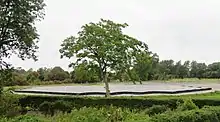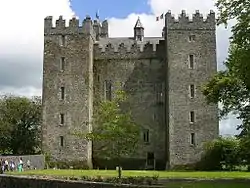Birr Castle
Birr Castle (Irish: Caisleán Bhiorra)[1] is a large castle in the town of Birr in County Offaly, Ireland. It is the home of the 7th Earl of Rosse and his family, and as such the residential areas of the castle are not open to the public,[2] though the grounds and gardens of the demesne are publicly accessible, and include a science museum and a café, a reflecting telescope which was the largest in the world for decades and a modern radio telescope.[3]


History
There has been a castle on the site since 1170, and from the 14th to the 17th century the O'Carroll family ruled from here over an area known as "Ely O'Carroll".[4]
After the death of Sir Charles O'Carroll, Sir Laurence Parsons (died 1628) was granted Birr Castle and 1,277 acres (5.2 km2) of land in 1620.[5][6] Parsons engaged English masons in the construction of a new castle on the site. This construction took place, not on the site of the O'Carroll's Black Tower (since disappeared), but at its gatehouse. "Flankers" were added to the gatehouse diagonally at either side, giving the castle the plan it retains today.[5]
After the death of Sir Laurence Parsons and of his elder son Richard, the castle passed to his younger son William.[7] During the Irish Rebellion of 1641 William was besieged at Birr for fifteen months by Catholic forces. After the civil war, William's son Laurence (baronet from 1677) refurbished the castle.[8]
A later descendant – Laurence Parsons, 2nd Earl of Rosse – also engaged in some re-building, and heightened and "Gothicised" the castle in the early 19th century. In turn, his son, the 3rd Earl of Rosse, was responsible for the construction of the great telescope at Birr. When completed in 1845, it was the largest telescope on Earth, and capable of capturing more light and seeing further into space than any telescope had done before. Birr therefore became a focus for astronomical observations, and visitors came to visit the observatory from all over the world - including Charles Babbage and H.I.H. Napoléon Eugène, Prince Imperial.[5]
When the 3rd Earl died, his sons continued the scientific tradition, and Lawrence Parsons, 4th Earl of Rosse is noted for measuring the heat of the moon.[9] After his death in 1908, however, the telescope fell into disrepair; the mirror was taken to the Science Museum in London, and, circa 1914, the telescope's metal supporting structure was melted down to be used in the First World War. In 1925 the wooden structures around the walls were demolished for safety reasons. Following several intermediate restoration attempts, the telescope was restored more completely in the late 1990s.[10]
The demesne
Situation
The demesne runs south and southeast of Birr town centre. The main public entrance is through a courtyard; there is no direct public access to the castle, which faces into the demesnse, with an internal gate on a bridge over a dry moat separating the castle's inner surrounds from the broader parkland. The entrance courtyard contains the Science Centre, café, shop and garden entrance, while the family have an ornamental private road gateway, with a large adjoining gate lodge, occupied by a staff member, just to the north.
Birr's main river, the River Camcor, enters the demesne near the castle, and continues through a pond to flow into the Little Brosna River, which in turn marks the border between Counties Offaly and Tipperary, and flows on to the Shannon. The demesne is open to the public for a fee, with an annual subscription available for Friends of Birr Castle Demesne.
Ireland's Historic Science Centre
The castle grounds are also home to Ireland's Historic Science Centre, a museum of Ireland's historic scientists and their contributions to astronomy and botany. The museum lies within a courtyard off William Street. Its displays touch on astronomy, engineering, photography, botany and other topics.[3][11] Laurence Parsons, 4th Earl of Rosse and his mother, Mary Parsons, Countess of Rosse, were eminent photographers, and her darkroom, which is also on show within the museum, is believed to be the oldest surviving example in the world.[12]
Café and shop
In the same courtyard as the Science Centre are the Castle Courtyard Café and a small shop.[3]
Parklands and gardens
The grounds of the castle contain the oldest wrought-iron bridge in Ireland, dating from 1820.[13][3] There was also an early hydroelectric station by the bridge and castle.[14]
The walled gardens in the grounds feature Box Hedges that are over 300 years old. They are also, according to The Guinness Book of Records, the tallest hedge in the world.[15]
The Irish entry to the 2014 European Tree of the Year contest was the Birr Castle Grey Poplar (Populus x canescens). On 12 February 2014, while voting was still open, it was blown down in a storm.[16]
Membership and sponsorship
The demesne's charitable foundation offers quarterly, half-yearly and annual memberships, including unlimited visiting.[17]
The grounds also contain a plantation of sequoia redwoods from California, Giants' Grove, which are available for sponsorship,[3] and the trees from a past sponsorship scheme operated with Crann.
Astronomy
The "Great Telescope" - The Leviathan

A major feature on the grounds of the castle is the "Great Telescope" or Leviathan of Parsonstown or The Rosse Telescope of the third Earl of Rosse, an astronomical telescope with a 183-cm (72 in) reflector. It was completed in 1845 and was used for several decades before the last observations were made in the first years of the 20th century. Its record size was not surpassed until the completion of the 100-inch (2.5-meter) Hooker Telescope at Mount Wilson Observatory in 1917. It was dismantled in 1914, but the structure was restored and the telescope reconstructed in the 1990s and is accessible to the public,[3] with occasional demonstrations of its movement, and talks.[18]
Modern radio-telescopy
The demesne hosts two radio-telescopy projects in the Mount Palmer division near the Little Brosna and the County Tipperary border. Astrophysicist Peter T. Gallagher of Trinity College Dublin met Lord Rosse in 2010 while visiting the Demesne in search of suitable quiet sites for radio-telescopy projects, and they agreed to repurpose an old sheep yard.[19]
The agreement led to the establishment of the Rosse Solar-Terrestrial Observatory, a Trinity College Dublin project, which was formally opened and blessed on June 28 2014, though already fully functional, with antennae picking up solar activity, even in cloudy weather. The sheep pen building was converted into a control room, and a magnetometer, jointly operated between TCD and the Dublin Institute for Advanced Studies, was also installed. Already by 2014, a major solar burst was detected by the Birr system, and reported in Nature Physics.
In the meantime the project team started work on establishing the I-LOFAR radio-telescope station (IE613), a node in a Europe-spanning network, which was largely built in 2016, and was switched on at Birr in 2017. Constructed in fields in the Mount Palmer area, between the Rivers Camcor and Little Brosna, it comprises around 3,000 antennae and 55 km of cabling, and eircom installed upgraded fibre to enable massive data carriage for it.[20] This is the westernmost station in the LOFAR network. The I-LOFAR telescope, in 2018, observed for the first time a billion-year-old red-dwarf, flare star called CN Leo, almost 75 trillion kilometres away.[21] There is a viewing point provided for visitors to the demesne to overlook the telescope structure.[3]
Notes
- "Archived copy". Archived from the original on 17 November 2017. Retrieved 14 June 2012.CS1 maint: archived copy as title (link)
- The Birr Scientific and Heritage Foundation. "Birr Castle". BirrCastle.com. Archived from the original on 21 September 2008.
- Birr Castle Gardens and Science Centre Visitor Guide. Birr, County Offaly: Birr Castle and Demesne. June 2018.
The Castle Courtyard Cafe,
- The Birr Scientific and Heritage Foundation. "Birr Castle Grounds". BirrCastle.com. Archived from the original on 21 January 2008.
- The Birr Scientific and Heritage Foundation. "Birr Castle, Co. Offaly". Archived from the original on 7 August 2008.
- cites: Mosley 2003, p. 1327
- The Birr Scientific and Heritage Foundation. "Birr Castle demesne, Voyage of discovery: Family History". Archived from the original on 15 January 2012. Retrieved March 2012. Check date values in:
|access-date=(help) - O’Byrne, Robert. "Ireland's Historic Birr Castle Receives a Chic Makeover". Architectural Digest. Retrieved 15 December 2020.
- "Parsons, Laurence". www.askaboutireland.ie. Retrieved 15 December 2020.
- Detail on telescope reconstruction Archived 27 September 2008 at the Wayback Machine
- The Birr Scientific and Heritage Foundation. "Ireland's Historic Science Centre". BirrCastle.com. Archived from the original on 18 September 2008.
- "Photography - Mary Rosse | Birr Castle, Gardens & Science Centre | Ireland". Retrieved 15 December 2020.
- The Rough Guide to Ireland, 9th Edition; p 219 ISBN 978-1-85828-056-1
- "hydroelectric power station". europeana.eu. Retrieved 13 October 2020.
Stone structure, built c.1879, as part of the civil engineering works regulating the flow of the Camcor river mainly for generating electricity at the turbine.
- "The Box Hedge". Archived from the original on 1 July 2008. Retrieved 15 November 2007.
- https://www.irishtimes.com/life-and-style/homes-and-property/gardens/storm-casualties-ireland-s-lost-trees-1.1706766
- "Become a "Friend" of Birr Castle Demesne". Birr Castle Demesne. Retrieved 26 October 2020.
- Ahlstrom, Dick. "`Leviathan' part of bigger picture showing contribution of Irish scientists". The Irish Times. Retrieved 15 December 2020.
- "Big Day For Birr With Launch Of Solar Observatory". Midland Tribune. 3 July 2020.
An important day in the history of Birr Castle took place on Saturday afternoon when a new space observatory was officially launched. ... possible that one day it could detect the existence of extra-terrestrial life. ... called the Rosse Solar-Terrestrial Observatory and it is located in former farmsheds and fields in the Mount Palmer sectionof the Demesne. A number of antennae are already in place in the Mount Palmer area, the farm sheds have been considerably renovated, and €300,000 has been raised for the project. ...
- "The BUild - I-LOFAR". Archived from the original on 30 June 2018. Retrieved 28 December 2017.
- Birr radio telescope catches flaring red dwarf 75 trillion kilometres away Irish Times, 2018-03-27.
References
- Mosley, Charles, ed. (2003). Burke's Peerage, Baronetage & Knightage (3 volumes). 1 (107th ed.). Wilmington, Delaware, U.S.A.: Burke's Peerage (Genealogical Books) Ltd. p. 1327.

